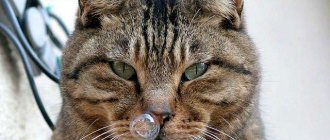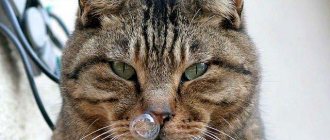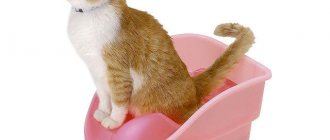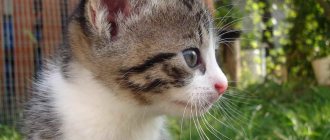The consequences of even the most harmless runny nose for a pet can be very serious. Cats' sense of smell is much more developed than that of humans, and it is inextricably linked with nutrition. An animal that has lost its sense of smell practically stops eating because it cannot smell the food. Due to prolonged fasting, problems with the digestive organs arise. This is just one of the reasons why it is necessary to fight a runny nose in cats.
Let's figure out what diseases rhinitis can be a symptom of and in what cases it can be cured at home.
Rhinitis in cats
Inflammation of the nasal mucosa is scientifically called rhinitis. We are not talking about a disease, but rather about a symptom that can accompany various diseases of infectious and non-infectious etiology.
A runny nose in a cat is easy to recognize even for a person ignorant of veterinary medicine. Characteristic manifestations of rhinitis are nasal discharge and frequent sneezing. When a cat owner observes such symptoms, he assumes that the pet has caught a cold. However, there are many causes of rhinitis, and many of them are quite serious.
It is imperative to diagnose and treat a runny nose in a kitten or an adult animal, otherwise it will become chronic. In addition, nasal discharge may indicate serious local and systemic pathologies.
Cat snot differs in color. Mucus can be transparent, light yellow, green or with a brown tint. The color may suggest a bacterial infection, the presence of a foreign object or tumor in the nasal passage.
Types of rhinitis
Runny nose in cats can be acute or chronic. In the first case, snot appears immediately after an infection enters the body that affects the upper respiratory tract. In this case, inflammation can affect not only the nasal mucosa, but also the paranasal sinuses and trachea.
Chronic runny nose develops gradually in cats and lasts a long time - from 2 weeks to several months. Symptoms of rhinitis either fade or reappear, but the snot never goes away. In most cases, chronic runny nose is the result of an untreated infectious disease or the appearance of tumors in the nose.
Causes of the disease
Causes of runny nose:
- hypothermia of the kitten, for example, as a result of walking in the cold, playing or sleeping in a draft;
- eating cold food or cold drink;
- allergic reaction: perhaps a new product has been included in the diet or the body has reacted with a runny nose, redness, lacrimation to dust, indoor plants, perfume aromas;
- a weakened immune system poorly resists infections, fungi, bacteria, and any infectious disease can insidiously manifest itself in the first days as a runny nose and other cold symptoms;
- due to the curiosity and playfulness of the kitten, a foreign object could be in the nose, causing the formation of mucus as a reaction to irritation;
- formation of tumors, polyps in the nasal passages;
- parasites (worms);
- strong odors that can cause sneezing and mucus from the nose;
- inflammation of the ear that spreads to the nasopharynx;
- congenital pathology of the nasopharynx (deviated nasal septum);
- chronic diseases passed on from the mother.
The main causes of a runny nose in a cat
Most often, snot in a cat appears due to a viral, bacterial or fungal infection. However, there are other causes of a runny nose:
- New growths in the nose - benign or malignant.
- Injury. A runny nose can develop when the upper palate is damaged. This happens when cats fall from a height and hit their face hard.
- Abscesses of teeth.
- Entry of a foreign body into the nasal passage.
- Allergies to chemicals or medications.
Viral infections
Viral agents provoke the rapid appearance of a runny nose. In cats, rhinitis occurs with calicivirus and herpes virus infection. Both diseases affect pets of different ages, but older animals, kittens and individuals with weakened immune systems are most susceptible to them.
Outbreaks of infections occur in autumn and spring. Cats become infected from sick animals or carriers of the virus through direct contact, as well as through aerogenic and nutritional routes.
The manifestations of viral diseases are largely similar:
- With herpes virus infection, runny nose, sneezing and fever are also observed. At the initial stage of the disease, the discharge from the nasal passages is serous, and then green snot appears. A sick cat's nose turns red, the gums and mucous membrane of the larynx swell. When examining the mouth, you can see a white coating on the tongue and the inner surface of the cheeks, as well as ulcers covered with crusts. When palpating the cat's neck, pain and anxiety are detected in the tracheal area.
- With calicivirus, a cat develops a runny nose, sneezing, red eyelids and watery eyes. First, mucus secretes from the nose, and it flows from two nasal passages. Later they become denser and change color to green. Then conjunctivitis develops. The cat's general condition is deteriorating - he loses his appetite, seems lethargic, and drowsy. Body temperature rises to 40.5 degrees. Ulcers appear on the mucous membranes of the mouth and on the nose, and an unpleasant odor is felt from the mouth. In some cases, cats experience diarrhea.
Bacterial and fungal infections
A runny nose can be caused not only by viral agents, but also by a bacterial or fungal infection. Prolonged snot in cats is caused by pathogenic bacteria - chlamydia, bordetella and mycoplasma. These microorganisms usually complicate the course of diseases caused by viral infections.
Sometimes the cause of a runny nose in cats is mycosis. A striking example of this is cryptococcus fungi, which affect the respiratory system, skin, eyes, and sometimes the brain. Infection occurs aerogenously - through inhalation of microorganisms.
Carriers of fungal infections are poultry, which excrete pathogens in their droppings. When a pet sniffs the ground, fungal spores enter the respiratory tract. Domestic cats can also get cryptococcosis if the owner brings the infection from the street on his shoes.
If this disease occurs in the nasal form, then it all starts with a runny nose. A little later, the pet sneezes, snorts, breathes heavily and coughs. Sometimes cryptococcosis is accompanied by damage to the eyes, and purulent exudate is released from them. If the cat is not treated, there is a risk of infection of the lining of the brain.
Aspergillosis is another disease whose symptom is a runny nose. Its causative agents are fungi of the genus Aspergillus. Infection occurs when a cat inhales spores of pathogens that are in the environment. Individuals with reduced immunity are most susceptible to this disease - those who have recently suffered viral infections or taken antibiotics.
- With sinonasal aspergillosis, serous or mucopurulent discharge can flow from one side or from both. In rare cases, in addition to a runny nose and sneezing, the animal may experience nosebleeds. A sick cat's breathing is difficult. Sometimes soft tissue protrudes from the nostrils and granulomas form.
- Sino-orbital aspergillosis is more severe - the fungus can affect the bones of the eye sockets. In this case, the sick cat develops unilateral exophthalmos, third eyelid prolapse or keratitis. In some animals, the central nervous system is affected, as evidenced by the appearance of neurological symptoms.
Neoplasms
Another cause of a runny nose is benign and malignant tumors in the nose.
Polyps
Nasopharyngeal polyps are common in cats and are one of the causes of nasopharyngeal diseases. They are formed due to a long-term inflammatory process, which can be caused by an infectious disease or allergy. Polyps grow gradually.
The severity of symptoms depends on the size of the tumor:
- the cat snores in her sleep;
- nasal breathing is difficult;
- the sense of smell partially or completely disappears;
- purulent snot flows;
- sometimes there is bleeding from the nasal passages;
- the cat sneezes often.
Attention! A runny nose, which is caused by the presence of a polyp, often has serious consequences. Due to the lack of smell, a sick cat loses its appetite and eats very little. This leads to exhaustion.
Malignant neoplasms
Common in cats:
- adenocarcinoma,
- lymphomas,
- sarcomas.
With cancer, a runny nose is of a different nature. Discharge appears on one or both sides. The snot is initially mucous, and later becomes purulent mixed with blood. Many cats experience swelling on their faces and their sinuses become deformed.
It is not possible to treat a runny nose caused by a malignant tumor at home. In this case, surgery and chemotherapy help.
Injuries and foreign bodies
Chronic runny nose occurs in a cat with a cleft palate. This pathology is the result of a strong blow due to a fall from a height. In this case, mucous or purulent exudate with food particles is released from both nostrils.
A runny nose in a cat also appears when the mucous membrane and soft tissues of the nasal passages are injured by a foreign body. The presence of a foreign object in the nasopharynx can be suspected if the cat is coughing, gagging, and the nostril feels hard and slightly swollen.
If the foreign body is not removed, clear discharge soon appears, then it changes color to greenish. Sometimes they contain blood. A runny nose is accompanied by sneezing, and breathing becomes difficult.
Other reasons
Less commonly, runny noses in cats occur due to allergies. The nasal mucosa becomes irritated when exposed to allergens - tobacco smoke, dust, pollen or chemicals. The cat often rubs its nose with its paw, sneezes and coughs. Partial or complete loss of smell is possible. With allergic rhinitis in cats, the discharge is clear and runny.
In kittens, a runny nose may be associated with an abnormality in the structure of the palate and nasal cavity. A striking example is the so-called cleft palate. This is a congenital pathology in which there is a hole between the palatine bones.
If such a defect is present, the kitten cannot normally suck mother's milk, since it enters the nasal cavity when swallowed.
Diseases of the teeth and gums can lead to a runny nose in a cat. When the root is inflamed, purulent snot usually flows from one side. In this case, swelling and redness are detected on the cat’s upper jaw.
How you can help treat your pet at home
Having received the test results and the doctor’s recommendations for treating your pet, you must begin the prescribed therapy.
Drugs should be given in the quantity and sequence as indicated by the doctor.
To carry out successful therapy at home, the following will have a positive effect:
- attentive attitude towards the animal;
- placing the bed in a warm, quiet place;
- availability of clean and fresh water at room temperature.
General and associated symptoms
Associated symptoms and treatment of a runny nose differ depending on the pathology that caused it. General manifestations of nasal discharge and sneezing may be accompanied by the following clinical signs:
- redness of the eyes;
- tearfulness;
- cough;
- ulcers on the oral mucosa;
- swelling and asymmetry of the muzzle;
- redness of the gums;
- sour eyes;
- protrusion of soft tissues from the nasal passages;
- snore;
- difficulty or noisy breathing;
- lack of appetite;
- weight loss;
- temperature increase;
- unpleasant odor from the mouth;
- lethargy, apathy.
It is important to carefully monitor your cat's condition when he has a runny nose and record any changes. This data will help the veterinarian find the true cause of rhinitis and prescribe the correct treatment.
Diagnosis of the disease
At the veterinary clinic, the doctor will ask about all the manifestations of the disease - when the cat started to have a runny nose, what accompanying symptoms have appeared recently. Next, the animal is examined. The veterinarian will evaluate the nature of nasal discharge, the condition of the oral mucosa, teeth, and measure body temperature. Additionally, you may need to examine your cat's ears using an otoscope.
Already at this stage, the doctor can exclude some pathologies. If he suspects a viral infection, he will have to take a PCR test from the nasal passages, as well as a blood test. Culture of the discharge will help confirm or rule out a bacterial infection.
Additional research methods will help detect tumors in the nose and dental problems in a cat:
- X-ray of the skull;
- CT scan;
- rhinoscopy;
- x-ray of tooth roots;
- biopsy of tissue of the nasal cavity.
Since some studies are carried out under general anesthesia, you will additionally have to take a biochemical test of blood and urine, do a cardiogram and a chest x-ray. It is also necessary to determine blood clotting indicators. Such an examination will help the veterinarian choose the right drug for anesthesia.
Methods for treating a runny nose in a cat
A veterinarian should prescribe a treatment regimen for cat runny nose. Therefore, if you find snot in a cat, you should not postpone your visit to the clinic.
You should not try to cure a runny nose on your own with human nose drops - this is very dangerous: your pet’s condition may worsen.
Treatment of infectious rhinitis at home
A sick cat needs good care. The animal is kept in a warm place without draft. The room is regularly ventilated. To ensure that the mucus that accumulates in the cat’s nose, bronchi and lungs is diluted and easily removed, it is advisable to use a humidifier.
Treatment of a runny nose in cats includes a number of measures:
- the use of antibiotics if the cat has snot that is caused by a bacterial infection;
- use of immunomodulators (for viral diseases);
- rinsing and instillation of the nose.
During illness, your cat needs to drink more fluids. If he refuses water, it is given from a syringe without a needle.
When cats have a runny nose, they lose their appetite, but they need to eat. You can offer your pet a light meal immediately after removing mucus from the nose.
Washing a cat's nasal passages
Rinsing the nose 2-3 times a day will help your cat recover faster. For this procedure you will need saline solution. You can buy it at a regular pharmacy or prepare it at home: dissolve a level teaspoon of salt in a liter of water, bring to a boil and cool to room temperature.
How the washing procedure is carried out:
- the cat is immobilized - wrapped in a large towel or blanket;
- the warm solution is drawn into a two-cc syringe without a needle;
- the nozzle of the syringe is inserted into the nostril and the liquid is slowly injected;
- the secreted mucus is removed with a napkin.
With viral diseases, cats also have conjunctivitis along with a runny nose. Therefore, the eyes also need to be washed (3-4 times a day). To do this, use either saline solution or warm boiled water. A clean cotton pad is moistened and crusts and pus are removed. You will need 4-6 sponges per eye. After this, you can use the drops prescribed by the veterinarian.
Expert opinion
Chepa Natalya Semenovna
Veterinarian
Ask an expert
To rinse the nose, you can use antiseptics, for example, Miramistin solution, Okomistin drops. These are safe medications for cats that not only moisturize the mucous membrane well, but also have an antimicrobial effect. Often animals with a runny nose have a dry nose, which also causes discomfort and unpleasant sensations. You can moisturize a dry nose with Bepanten ointment, which is quickly absorbed and safe for your cat to lick.
List of medications for a runny nose in a cat
Infectious runny nose is treated with medications. Many experts recommend using Anandin nasal-eye drops (immunomodulator). This drug is suitable if you need to cure snot in a kitten.
2-3 drops of the composition are administered into each nasal passage 3 times a day. It is advisable to do this after the procedure of rinsing the nasal passages.
If the runny nose is caused by a bacterial infection, the cat will be prescribed antibiotics:
- Amoxicillin;
- Enrofloxacin;
- Ceftriaxone.
You cannot use vasoconstrictor drops for the common cold for cats, such as Sanorin, Galazolin and others. It is unknown how the animal’s body will react to human drugs.
Gamavit can be used as a general tonic in a dosage of 0.3-0.5 ml per 1 kg of body weight. You can give your cat a vitamin complex.
Other treatments
If a runny nose is caused by a fungal infection, cats are prescribed antifungal drugs. The main attention is paid to strengthening the immune system.
If polyps are detected, their removal is recommended. If the cause of the runny nose is a malignant neoplasm, then treatment includes chemotherapy. Surgical intervention cannot be avoided even when a cat is diagnosed with congenital anomalies of the structure of the palate and nasal cavity.
If a runny nose is caused by a foreign body, it must be removed. Most often, fragments of dry grass and plant seeds get into a cat's nose. After removal of a foreign object, antibiotic therapy may be necessary in some cases.
How to treat runny nose and sneezing in cats
How to treat a cat if it has a runny nose and sneezes, again, only a doctor can tell.
If the situation is caused by an allergy, all possible causative agents are eliminated. For a cold, warming up, a course of antibiotics, drops, and rinsing the nasal passages with solutions are prescribed.
One way or another, without the help of a veterinarian it will not be possible to rid your cat of sneezing and a runny nose, so if you are concerned about the health and life of your pet, do not delay and immediately seek help from a veterinary clinic.
Prices for appointments in our network of veterinary clinics
| Name of veterinary services | Unit | Price, rub |
| ⭐ Initial appointment | 1 animal | 400 |
| ⭐ Repeated appointment | 1 animal | 250 |
| Initial appointment with a specialist | 1 animal | 1100 |
| Consultation without an animal | — | 550 |
| Consultation with a doctor based on test results | 1 PC. | 400 |
| Weighing animals | 1 animal | For free |
| Additional fixation for aggressive animal behavior | 1 animal | 700 |
All our Veterinary Clinics:
For any suggestions regarding the site: [email protected]
|










